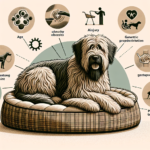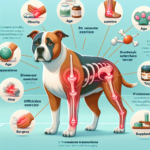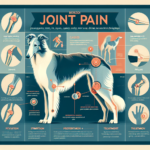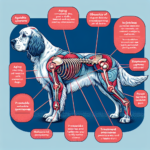Briard Joint Pain: Causes, Symptoms, Prevention, and Treatment

Introduction
The Briard, also known as the Berger de Brie, is a large, intelligent, and versatile herding dog that originated in France. With a history dating back to the 8th century, the Briard has been a loyal companion to farmers and shepherds, known for its ability to herd and guard livestock. This breed is characterized by its long, wavy coat, expressive eyes, and a strong, muscular build. Briards are known for their loyalty, intelligence, and protective nature, making them excellent family pets and working dogs.
Like many large breeds, Briards are prone to certain health issues, including joint pain. Joint health is a significant concern for Briard owners, as joint-related problems can severely impact the dog’s quality of life. Understanding the causes, symptoms, prevention, and treatment of joint pain in Briards is crucial for ensuring their well-being and longevity.
Breed-Specific Joint Pain Risks
Genetic Predisposition
Briards are genetically predisposed to several joint-related issues, including hip dysplasia, elbow dysplasia, and arthritis. Hip dysplasia is a condition where the hip joint does not fit properly into the hip socket, leading to pain and mobility issues. Elbow dysplasia involves abnormal development of the elbow joint, causing lameness and discomfort. Arthritis, a degenerative joint disease, can also affect Briards, leading to chronic pain and stiffness.
Age-Related Risks
As Briards age, the risk of developing joint pain increases. Senior Briards are more susceptible to arthritis and other degenerative joint conditions. It is essential for owners to monitor their Briards for signs of joint pain as they age, particularly after the age of seven, which is considered the senior stage for this breed.
Activity Level and Joint Stress
Briards are active and energetic dogs that require regular exercise to stay healthy. However, their high activity level can also contribute to joint stress, particularly if they engage in high-impact activities such as jumping, running on hard surfaces, or participating in agility sports. While exercise is essential for maintaining overall health, it is crucial to balance activity levels to prevent excessive joint strain.
Common Symptoms of Joint Pain in Briards
General Symptoms
- Limping or favoring one leg
- Stiffness, especially after rest or exercise
- Reluctance to move, jump, or climb stairs
- Decreased activity level or interest in play
- Swelling or heat around the joints
- Whining or showing signs of discomfort when touched
Breed-Specific Symptoms
In Briards, joint pain may manifest as a reluctance to perform tasks they previously enjoyed, such as herding or playing fetch. Due to their protective nature, they may also become more irritable or aggressive when experiencing pain. Owners should be vigilant for any changes in behavior that may indicate joint discomfort.
When to Consult a Vet
If a Briard exhibits any signs of joint pain, it is essential to consult a veterinarian promptly. Early intervention can help manage pain and prevent further joint damage. Owners should seek veterinary advice if their dog shows persistent limping, significant changes in activity level, or any signs of severe pain or discomfort.
Preventive Measures for Joint Health
Exercise Recommendations
Regular, low-impact exercise is crucial for maintaining joint health in Briards. Activities such as walking, swimming, and controlled play can help keep joints flexible and muscles strong without causing excessive strain. It is important to avoid high-impact activities that can stress the joints, especially in young puppies and senior dogs.
Dietary Suggestions
A balanced diet rich in essential nutrients can support joint health in Briards. Foods containing glucosamine, chondroitin, and omega-3 fatty acids are particularly beneficial for joint health. These nutrients can help reduce inflammation, support cartilage health, and improve joint function. Owners may also consider joint supplements, but it is essential to consult a veterinarian before adding any supplements to the dog’s diet.
Weight Management
Maintaining a healthy weight is crucial for reducing joint stress in Briards. Excess weight can exacerbate joint problems and lead to increased pain and mobility issues. Owners should monitor their dog’s weight and adjust their diet and exercise routine as needed to prevent obesity. Regular veterinary check-ups can help ensure the dog maintains a healthy weight.
Early Screening and Monitoring
Early screening for joint issues can help catch problems before they become severe. Regular veterinary check-ups, including orthopedic evaluations, can help identify early signs of joint problems. For Briards, it is also advisable to have their hips and elbows screened for dysplasia, especially if they are intended for breeding.
Treatment Options for Joint Pain
Non-Surgical Treatments
Non-surgical treatments for joint pain in Briards include medications, physical therapy, and lifestyle adjustments. Anti-inflammatory medications and pain relievers can help manage pain and reduce inflammation. Physical therapy, including exercises and massage, can improve joint mobility and strength. Lifestyle adjustments, such as providing a comfortable bed and avoiding high-impact activities, can also help manage joint pain.
Surgical Options
In severe cases of joint pain, surgical intervention may be necessary. Common surgical options for Briards include hip replacement, elbow surgery, and arthroscopy. These procedures can help alleviate pain and improve joint function. It is essential to consult a veterinary orthopedic specialist to determine the best surgical option for the dog’s specific condition.
Alternative Therapies
Alternative therapies such as acupuncture, hydrotherapy, and chiropractic care can also benefit Briards with joint pain. Acupuncture can help reduce pain and inflammation, while hydrotherapy provides low-impact exercise that can improve joint mobility. Chiropractic care can help realign the spine and joints, reducing pain and improving overall function. It is important to consult a veterinarian before starting any alternative therapies.
Lifestyle and Management Tips
Daily Care Routine
A daily care routine for managing joint pain in Briards should include regular, low-impact exercise, a balanced diet, and any prescribed medications or supplements. Owners should also provide a comfortable sleeping area with an orthopedic bed and avoid activities that can stress the joints.
Modifying the Home Environment
Making the home environment more comfortable for a Briard with joint pain can significantly improve their quality of life. Consider installing ramps to help the dog navigate stairs and providing non-slip flooring to prevent falls. An orthopedic bed can provide additional support and comfort for sore joints.
Long-Term Management
Long-term management of joint pain in Briards involves regular veterinary check-ups, ongoing monitoring of the dog’s condition, and adjustments to their care routine as needed. Owners should remain vigilant for any changes in their dog’s behavior or mobility and consult their veterinarian promptly if any issues arise. With proper care and management, Briards with joint pain can continue to lead active and happy lives.
FAQs About Briards and Joint Pain
What are the early signs of joint pain in Briards?
Early signs of joint pain in Briards include limping, stiffness, reluctance to move, and decreased activity levels. Owners should also watch for changes in behavior, such as irritability or aggression, which may indicate discomfort.
Can joint pain in Briards be prevented?
While it may not be possible to prevent all cases of joint pain, taking preventive measures such as regular exercise, a balanced diet, weight management, and early screening can help reduce the risk and severity of joint issues.
Are there specific exercises that are better for Briards with joint pain?
Low-impact exercises such as walking, swimming, and controlled play are ideal for Briards with joint pain. These activities help maintain joint flexibility and muscle strength without causing excessive strain.
What dietary supplements can help support joint health in Briards?
Supplements containing glucosamine, chondroitin, and omega-3 fatty acids can support joint health in Briards. These nutrients help reduce inflammation, support cartilage health, and improve joint function. Always consult a veterinarian before adding supplements to your dog’s diet.
When should I consider surgical options for my Briard’s joint pain?
Surgical options should be considered if non-surgical treatments are not effective in managing your Briard’s joint pain or if the condition is severe. Consult a veterinary orthopedic specialist to determine the best surgical option for your dog’s specific condition.
Conclusion
Joint pain is a significant concern for Briard owners, but with proper understanding and management, it is possible to ensure a high quality of life for these loyal and intelligent dogs. By recognizing the causes and symptoms of joint pain, taking preventive measures, and exploring various treatment options, owners can help their Briards lead active and happy lives. Regular veterinary check-ups and early intervention are crucial for maintaining joint health and addressing any issues promptly. With the right care and attention, Briards can continue to be the loving and energetic companions they are known to be.




